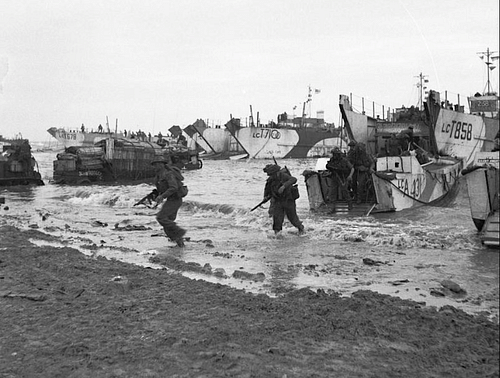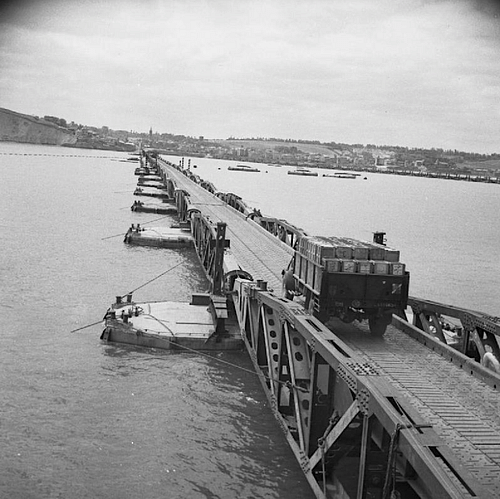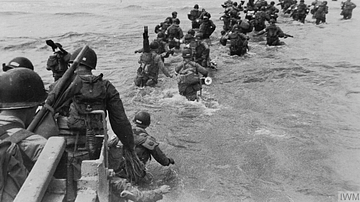
Gold Beach was the central of the five Allied D-Day Normandy landings of 6 June 1944. Primarily British units, with massive naval and air support, were set the task of taking the beach, a feat achieved by the end of the day, using a combination of armoured vehicles and infantry who negotiated mines and obstacles to storm the German defences.
Gold Beach was linked with its neighbouring beachheads as the battle for the beaches evolved into the Battle for Normandy. A floating Mulberry harbour was then built at Gold Beach, which allowed a massive amount of men and equipment to be landed in support of the ever-expanding Allied front in Normandy.
Operation Overlord
The amphibious assault on the beaches of Normandy was the first stage of Operation Overlord which sought to free Western Europe from occupation by Nazi Germany. The supreme commander of the Allied invasion force was General Dwight D. Eisenhower (1890-1969), who had been in charge of the Allied operations in the Mediterranean. The commander-in-chief of the Normandy land forces, 39 divisions in all, was the experienced General Bernard Montgomery (1887-1976). Commanding the air element was Air Chief Marshal Trafford Leigh Mallory (1892-1944), with the naval element commanded by Admiral Bertram Ramsay (1883-1945).
Nazi Germany had long prepared for an Allied invasion, but the German high command was unsure where exactly such an invasion would take place. Allied diversionary strategies added to the uncertainty, but the most likely places remained either the Pas de Calais, the closest point to British shores, or Normandy with its wide flat beaches. The Nazi leader Adolf Hitler (1889-1945) attempted to fortify the entire coast from Spain to the Netherlands with a series of bunkers, pillboxes, artillery batteries, and troops, but this Atlantic Wall, as he called it, was far from being complete in the summer of 1944. In addition, the wall was thin since there was no real depth to the defences.
Field Marshal Gerd von Rundstedt (1875-1953), commander-in-chief of the German army in the West, believed it would be impossible to stop an invasion on the coast and so it would be better to hold the bulk of the defensive forces as a mobile reserve to counterattack against enemy beachheads. Field Marshal Erwin Rommel (1891-1944), commander of Army Group B, disagreed and considered it essential to halt any invasion on the beaches themselves. Further, Rommel believed that Allied air superiority meant that movements of reserves would be severely hampered. Hitler agreed with Rommel, and so the defenders were strung out wherever the fortifications were at their weakest. Rommel improved the static defences and added steel anti-tank structures to all the larger beaches. In the end, Rundstedt was given a mobile reserve, but the compromise weakened both plans of defence. The German response would not be helped either by their confused command structure, which meant that Rundstedt could not call on any armour (but Rommel, who reported directly to Hitler, could), and neither commander had any control over the paltry naval and air forces available or the separately controlled coastal batteries. Nevertheless, the defences were bulked up around the weaker defences of Normandy to an impressive 31 infantry divisions plus 10 armoured divisions and 7 reserve infantry divisions. The German army had another 13 divisions in other areas of France. A standard German division had a full strength of 15,000 men.
Operation Neptune
Preparation for Overlord occurred right through April and May of 1944 when the Royal Air Force (RAF) and the United States Air Force (USAAF) relentlessly bombed communications and transportation systems in France as well as coastal defences, airfields, industrial targets, and military installations. In total, over 200,000 missions were conducted to weaken as much as possible the Nazi defences ready for the infantry troops about to be involved in the largest troop movement in history. The French Resistance also played their part in preparing the way by blowing up train lines and communication systems that would ensure the German armed forces could not effectively respond to the invasion.
The Allied fleet of 7,000 vessels of all kinds departed from English south-coast ports such as Falmouth, Plymouth, Poole, Portsmouth, Newhaven, and Harwich. In an operation code-named Neptune, the ships gathered off Portsmouth in a zone called 'Piccadilly Circus' after the busy London road junction, and then made their way to Normandy and the assault areas. At the same time, gliders and planes flew to the Cherbourg peninsula in the west and Ouistreham on the eastern edge of the planned landing. Paratroopers of the 82nd and 101st US Airborne Division attacked in the west to try and cut off Cherbourg. At the eastern extremity of the operation, paratroopers of the 6th British Airborne Division aimed to secure the bridges and eastern flank of the invasion.
Attacking Gold
The amphibious attack was set for dawn on 5 June, daylight being a requirement for the necessary air and naval support. Bad weather led to a postponement of 24 hours. Shortly after midnight, the first waves of 23,000 British and American paratroopers landed in France. From 3:00 a.m., air and naval bombardment of the Normandy coast began, letting up just 15 minutes before the first infantry troops landed on the beaches at 6:30 a.m. The area was divided into five beaches, each with its own code name. While US troops attacked Utah Beach and Omaha Beach to the west, primarily Canadian troops landed at Juno Beach, and British troops launched an assault on Gold Beach and Sword Beach.
Gold Beach, located in front of the towns of Arromanches, Asnelles, and La Rivière, was attacked by the 50th British Infantry Division of the 30th British Corps, part of the 2nd British Army commanded by Lieutenant-General Miles C. Dempsey. The troops assaulting Gold Beach were amongst the most experienced fighting units of the entire Normandy landings. These forces included the famous "Desert Rats", the 7th Armoured Division, which had earned its name fighting Germany's Afrika Korps in North Africa earlier in the Second World War. There were veterans of the campaign in Sicily, as well as the famed and battle-hardened Green Howards infantry, and units of Royal Marine Commandos. In command of the assault on Gold Beach was Major-General Douglas Graham.
Gold Beach, which was 5 miles (8 km) long, was divided into four operational sectors (west to east): How, Item, Jig, and King. There were major defensive gun batteries at Longues-sur-mer. Located to the west of Gold Beach and set back a mile or so from the beach, the gunners of these four 155-mm (6 in) guns received range information by telephone from observers inside a concrete bunker, which overlooked the beach itself.
Allied bombers had failed to knock out the Longues guns, but they were a target for the naval fleet designated to cover Gold Beach. The Royal Navy cruisers Ajax (famous veteran of the Battle of the River Plate of 1939) and Argonaut repeatedly shelled the guns at Longues and Le Hamel. The precise coordinates of the Longues battery had been passed on by the French Resistance, who had themselves gained the information via a history professor who had been given them by the farmer who owned the land whose blind son had paced out the distances right under the German troops' noses, such was the often precarious but nevertheless effective chain of intelligence information that helped the Allies when it mattered. Ajax also bombarded other defensive positions, entirely destroying one emplacement when its magazine exploded. The resulting smoke from the naval bombardment, and from rockets launched by smaller ships and the covering fire, bombs, and rockets coming from above via Supermarine Spitfires and Hawker Hurricanes, all helped create a thick smokescreen that blew across the beach.

The first wave of troops landed at Gold at 7:25 a.m. As at other beaches during the battle, the individual commanders of landing craft were reluctant to go too near the beaches for fear of beaching their craft which would prevent them from withdrawing and taking on more vehicles for the next waves. This meant that some of the specialised and Sherman tanks were launched too early in too deep water, so they sank. Many vessels, before the demolition engineers could get to work, were blown up by mines. Another repeated feature of the landings seen at Gold Beach was the fact that the tanks took longer than expected to get onto the beach and so were overtaken by the next waves of landing craft carrying the infantry.
Gunner Ramsey Bader remembered hitting the beach in his tank:
The first tank coming off my LCT didn't make it. We were too far out, obstacles stopped the tank and those people were obviously drowned: the tank just sank. I was the next off, hoping we wouldn't hit any mines and obstacles in the water, but we kept going and we made the shore with our guns firing.
(Bailey, 249).
The rough seas and high tide meant that many beach obstacles were made even more dangerous by being submerged and out of sight. The infantry tossed about in the unwieldy landing craft began to regret their obligatory breakfast of fried eggs and rum. Another consequence of the high tide (higher than the previous day) was that the beach was narrower than planned and getting ever narrower as the morning progressed. With fewer tanks landed than hoped for, the infantry had very little cover from the withering defensive fire, resulting in many commanders and officers being killed within minutes of the landing.

The invasion was, if anything, relentless. Eventually, sufficient armoured vehicles were landed to fulfil their function of clearing strips of the beach of mines and other obstacles and taking on the pillboxes from which the enemy could fire upon the landing troops. Mines on the beaches wrecked many tanks, but these became useful points of refuge for the infantry who were subjected to mortar, machine-gun, and sniper fire. Troops came in wave after wave and began exiting the beach, pushing on towards inland towns like Ryes, Bazenville, Mont Fleury, and Crépon.
Leading Seaman Wally Blanchard, part of an obstacle-clearing unit, gives the following summary of the action as he worked clearing mines on Omaha Beach and Gold Beach:
Your actions are almost automatic. I was clipped more than once by bullets or ammunition. It didn't seem to matter. Nothing really hit me. It was pinging and clanging off you like rain…an awful lot of people were killed on that beach [Omaha]…back again to my own beach, Gold Beach…There's so much confusion; surprising things happen. You look along the beach and suddenly see a whole warship, a minesweeper, she's struck a mine, she seems to go up in the air and disintegrate completely. People scream, they shout. They call out for mothers and Lord knows what. They all seem younger than you. I was eighteen.
(Bailey, 282-3)
While many German troops (a large proportion of which were Russian, Lithuanian, Polish, and Czech conscripts) surrendered without too much resistance, there were areas of fierce fighting, notably at La Rivière where there was house-to-house fighting. Here the defenders were well-protected by a series of concrete bunkers that proved highly resistant to all Allied aerial bombardment. When a specially adapted tank of the Royal Engineers arrived, it was able to fire 40-lb (18 kg) shells that finally broke down the concrete defences. Flame-throwing vehicles and acts of individual heroism did the rest. The only Victoria Cross Medal (the highest honour in the British army) awarded on D-Day was given to Company Sergeant Major Stanley Hollis of the Green Howards for his courageous attacks on several different enemy gun positions.
Major Richard Gosling describes the aftermath of an assault on a pillbox behind Gold Beach:
Just behind the sand dunes there was a German pillbox, which the Germans had used as a sleeping quarters, and they turned it into a little first-aid post for us and we crawled into this. Very smelly it was of Germans. They'd been standing to that morning and the remains of their breakfast was on the tables still and some red wine on the table and there was a letter from a French girl to one of the Germans. It was 'Hans chéri' - Dear Hans - 'Je vous attendrais' - I will meet you - 'derrière le pillbox' - behind the pillbox - 'à six heures du soir' - at six o'clock in the evening - 'le six juin' - on the sixth of June. And it was signed 'Madelaine'. So Madelaine was going to meet this German behind the pillbox at six o'clock that evening. So we all looked out and waited for Madelaine to come along. Madelaine never did.
(Bailey, 367)
Another story reflecting the individuality of actions on a momentous day of collective effort is told by Sergeant James Bellows:
Just off the beach there were two or three little cottages and opposite these cottages there was a road that led from the beach and one of our men had been killed and his mates had just dug a hole and covered him. The reason they had done this was because, if they hadn't, it was more than probable he'd have been run over by all sorts of things, tanks, you name it. It was a humanitarian gesture, you might say. And as I was walking by, out of one of those cottages came an old lady. Goodness knows how old she was. Skirts were touching the ground. And she hobbled across the road and in her hand she had a posy of flowers and she placed them on the grave, kneeled, said a prayer, got up, gave the sign of the cross and then walked back to her cottage. It was one of the most moving sights I think I saw in the war.
(Bailey, 258-9)
The guns at Le Hamel were finally put out of action by mid-afternoon, and much useful equipment began to arrive, such as mobile heavy artillery pieces. However, the defenders were now regrouping more effectively, and German panzers moved to engage British tanks at Creully, where there was a key bridge across the River Seulles. As at other beaches, naval bombardment came to the assistance of land troops, and Creully was secured. The Gold beachhead was also now secure and expanding towards Bayeux, a vital transport hub for the region as it controlled the N13 road from Cherbourg to Caen. The British commanding officer decided that, with daylight running out, it would be prudent to remain on Bayeux's outskirts until the next day.
On D-Day, 24,970 troops were landed at Gold Beach, with 400 casualties (although there are no official figures for D-Day itself, and estimates can vary). By the end of 7 June, Bayeux had been taken peacefully, and the troops on Gold Beach had linked up with their counterparts on either side at Omaha Beach and Juno Beach. This small part of occupied Europe was now free, as observed in a diary by Mademoiselle Genget, a resident of St.-Côme-de-Fresne:
We were at last liberated. The enormous strength that all this war material represents is fantastic, and the way it has been handled with such precision is marvellous…A group of Tommies pass and ask us for water. We fill their bottles, say a few words, and, having given chocolate and sweets to the children, they continue on their way.
(Ambrose, 530)
The Battle for Normandy
By the end of D-day, 135,000 men had been landed and relatively few casualties were sustained – some 5,000 men. The defenders eventually organised themselves into a counterattack, deploying their reserves and pulling in troops from other parts of France. This is when French resistance and Allied aerial bombing became crucial, seriously hampering the German commanders' efforts to reinforce the coastal areas of Normandy. Most of the German generals wanted to withdraw, regroup, and then reattack in force, but, on 11 June, Hitler ordered there be no retreat. By mid-June one of two floating Mulberry harbours had been built to link incoming shipping to Gold Beach at Arromanches. Built from over 200 prefabricated parts, this harbour allowed some 11,000 tons of material to be landed every 24 hours.
Operation Neptune officially ended on 30 June. Around 850,000 men, 148,800 vehicles, and 570,000 tons of stores and equipment had been landed since D-Day. The next phase of Overlord was to push the German army out of Normandy, but this proved more difficult than anticipated with the defenders fighting resolutely and aided by the broken bocage countryside of fields and hedgerows. There were some serious Allied setbacks such as the staunch defence of Caen and very heavy fighting around Avranches. It was not until August that General Patton and the US Third Army were punching south at the western side of the offensive. The Brittany ports of St. Malo, Brest, and Lorient were taken, and the Allies swept southwards to the Loire River from St Nazaire to Orléans. On 15 August, a major landing took place on the southern coast of France, the French Riviera Landings. On 25 August, Paris was liberated. The northern and southern Allied armies linked up in September and pushed the German army back towards Germany as the Second World War reached its final phase.









